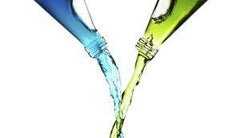Your hydronic heating or cooling system needs to be drained for a cleaning or it is time to replace your heat transfer fluid. Do you know how much fluid your system holds? When it is time to refill, you need to know your system's volume to order the right quantity of glycol. But what if you don't know what that amount is? How do you determine the volume of glycol required for your hydronic HVAC system? Let's explore how to determine volume.

In this article, we will discuss two methods to accurately measure system volume of heat transfer fluids. While neither are 100% precise, they will get you a close approximate volume which can be used to place your order.
-
Calculate Using Mechanical Specifications and Drawings. In this method we calculate the water volume of the system by adding up the estimated volume of each of the system's components: supply and return pipe (calculate volume of water in a pipe by using pipe length and radius, which is diameter divided by 2), boilers/chillers, heat exchangers, expansion tanks, pumps, coils, etc. Using specs and drawings gives us a bird's eye view of the system or you could walk the system and take note of each component. In large buildings or in situations that are time sensitive, this method may not be preferred. How do you calculate volume of water in a pipe?
Volume of Water in Pipe Formula: π x Pipe Length x Radius (Where Radius = Inner Diameter Divided by 2)
-
Determine System Volume Using a Meter. Assuming there is a single point in the system where all heat transfer fluid can be drained, using a meter, such as those manufactured by Badger Meter, to measure the volume of fluids drained is a great option. Note that up to 10% of the system's volume will be retained and will not drain, so you must add that to your meter reading when calculating total system volume. If you need empty glycol containers to drain your solution into while performing this test, you can purchase them here.
If you have questions about measuring how much glycol is needed or need help with an upcoming heat transfer project, contact us today.








